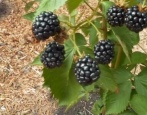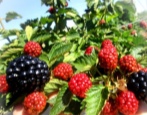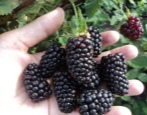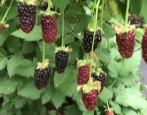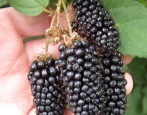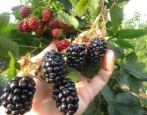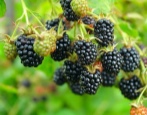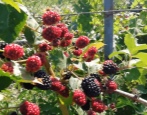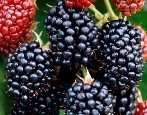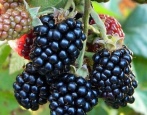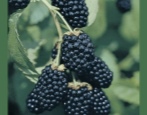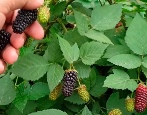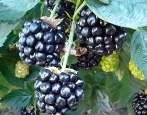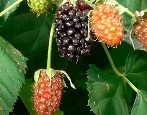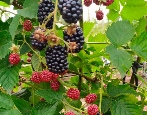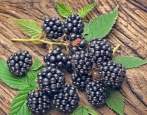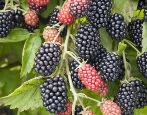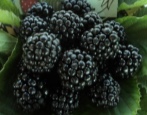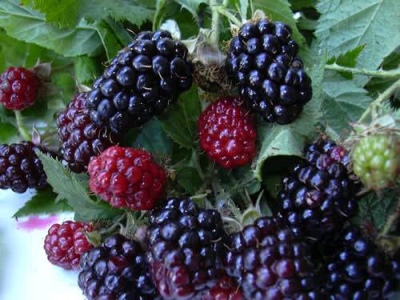
- Authors: John Perkins, America
- Taste: sweet
- The presence of thorns: Yes
- Berry weight, g: up to 3 g
- Berry size: large
- Berry color: black
- Fruiting period: Aug. Sept
- Yield: up to 10 kg per bush
- Drop off location: open, protected from wind
- Frost resistance, ° C / Winter hardiness: winter hardy, up to -30 ° C
Currently, the range of blackberry varieties is constantly increasing. Breeders are constantly working on the development of new varieties, which are distinguished by a rich harvest, unpretentious care, good taste. One of these varieties is the Agavam blackberry.
Breeding history of the variety
The Agavam variety was bred by breeders in the middle of the 19th century. There is very little information about the origin of the variety. It is known that American breeder John Perkins worked on the development of blackberries. To obtain this culture, North American wild species were taken. Which ones are unknown. Blackberry Agavam has a synonym for the name (or Latin name) Agavam. For several decades, the variety was one of the ten most common varieties in America and Europe. It was included in the Russian State Register in 2006.
Description of the variety
This blackberry is considered one of the tastiest and largest varieties. The plant has tall, vigorous upright bushes. Their height reaches from 180 to 220 cm. Tall, thick, erect shoots with drooping tops are covered with thorns, which are bent downwards. Medium-sized brown spines are stiff and rather sharp. Young shoots at the beginning of the growing season are green, by the end they darken, and in the second year they acquire a brown tint. The Agavam variety has peculiar corrugated leaves of a dark green color, which have a 5-leaf shape. They have strong pubescence and narrowed leaf tips. There are small thorns on the veins from the bottom of the leaf. The leaves are very well attached to the shoots, so a lot of unopened leaves remain on the bushes during the winter. Large white flowers are collected in racemose inflorescences. The Agavam variety grows very well.
Ripening terms
Flower buds are mainly formed on two-year-old shoots. Blackberries begin to bloom in May, harvesting begins in August and continues until the end of September.
Growing regions
This variety is grown in all regions of the earth. The cultivation of blackberries in different regions differs only in the agricultural care for it.
Yield
The crop has a high yield. Up to 10 kg of ripe berries can be harvested from one blackberry bush; under very good weather conditions and sufficient agricultural care, some gardeners collected up to 15 kg of excellent fruits.
Berries and their taste
Large fruits of this variety weigh up to 3 grams. The shape of the berries is short-conical. 17-19 fruits grow on one bunch, which do not ripen at the same time. Ripe berries are black. The taste is sweet, with a delicate unique aroma. The pulp is dense, due to which the harvested crop tolerates transportation well and is stored for a long time. Fruit tasting score - 4.5 points.
Growing features
In order to get a lot of berries, you must follow a number of rules. When choosing a soil, preference should be given to loams; it is also necessary to install drainage. In order for the bushes to grow well, you need to prune in time. To keep moisture in the soil longer, mulching should be done. And you also need to water the area where the blackberry grows on time. Lack of moisture is bad for yields.
Site selection and soil preparation
You need to plant seedlings in an open, sunny place that is well protected from wind and drafts. Before planting, the site is dug up, all weeds are removed.Then the earth is fertilized with a mixture of superphosphate, humus and potassium salt in an amount of 150 g, 3-4 kg and 40 g, respectively. The soil must be drained and well filled with humus.
Pruning
The bushes are vigorous, therefore it is recommended to cut them 3 times during the growing season. In the spring, it is necessary to cut off old shoots so that they do not shade the young ones. You need to cut off by 5-6 buds. In July, it is recommended to cut off 10 cm from the top of young shoots. In the fall, after the entire crop has been harvested, remove all the shoots that did not bear fruit, as well as thin, short or damaged young shoots. For the winter, 8 to 10 shoots should remain on the bush. In the spring, you need to remove all frozen shoots.
Watering and feeding
The variety is not hygrophilous, but the bushes need to be watered regularly. A bucket of water is poured under each bush once a week. At the beginning of the growing season, if the ground is wet after the snow melts, watering can be done less frequently. During the period of fruit setting, watering is increased, and 2-3 buckets are poured under each bush.
Fertilizing the area with blackberries also needs to be correct. Not having enough or applying too much fertilizer will also have a bad effect on the crop. For the first 2 years, the site does not need fertilizers, since all the necessary substances were added before planting. In the third year, organic fertilizers and humus are applied, they will help to grow foliage. At the beginning of the growing season, nitrogen compounds are introduced under each bush (for 10 liters of water, 1-2 tablespoons of urea). 200 ml of solution is poured under each bush. Wood ash will also be a good fertilizer. It is scattered under each bush in a thin layer.
Frost resistance and preparation for winter
High frost resistance up to –30 ° С allows in central Russia not to cover the bushes for the winter. In more northern regions, shelter is needed, but it is not recommended to bend the shoots to the ground, as they can break. Therefore, the bushes are hung with agrofibre or other materials.
Diseases and pests
The variety is resistant to diseases and pests. For preventive purposes, in autumn and spring, the bushes are treated with copper sulfate or other preparations that contain copper.
Reproduction
The Agavam variety propagates in 4 ways: by offspring, seeds, cuttings and dividing the bush.
The simplest of them is reproduction by offspring. To do this, the offspring are dug up in the spring, the tops are cut off by 30-35 cm. And they are transplanted to another place. Propagated by seeds is extremely rare, since this is a complex process that does not give good results. Dividing the bush is also a good way. To do this, a large bush is dug up and divided into several parts so that each of them has a good root system.


